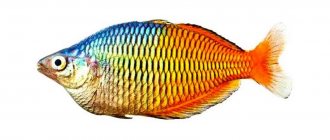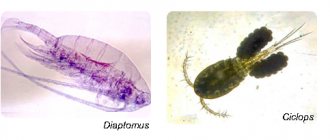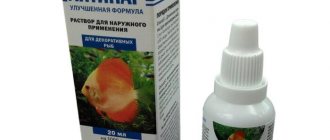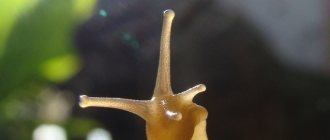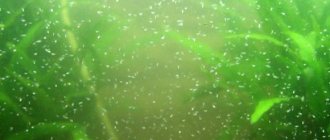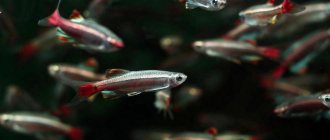What foods are called frozen?
Mostly live food is frozen, sorted by type and size. These are small species of crustaceans, worms and larvae. The advantage of this food is that it retains its nutritional properties and naturalness.
Popular types of frozen food for aquarium fish:
- Artemia.
Gill-footed crustacean 1-2 cm long and weighing 10 mg. The color depends on its diet and can be greenish or red. Artemia (including nauplii - its larvae) is one of the most highly nutritious foods for fish (the protein content in it is up to 60%, fat - 20%). Feeding this species improves coloration, ensures growth and high survival rates. Artemia promotes the natural behavior of aquarium fish.
- Gammarus.
A small crustacean measuring 5-25 mm (depending on living conditions and age). Color: gray-yellow and greenish.
Gammarus contains a large amount of protein (50%), while fat is only 6% and carbohydrates - 3%. Promotes proper digestion, active growth and enhancement of the natural color of fish. This food is alternated with low-calorie types of food.
- Daphnia.
Cladoceran crustacean, kidney-shaped, up to 6 mm in size. It is a good herbal supplement for feeding fish, as it contains many plant components.
Daphnia contains a large percentage of protein - about 50%, while fat - only 15 - 25%. This type of crustacean is highly nutritious and helps improve intestinal motility.
- Koretra.
Coretra is the name given to an elongated mosquito larva, 1-2 cm long. Its body is translucent and has a greenish or sandy color.
This type of food is low-calorie (protein content - 40%); it is combined with high-calorie feeds. Feeding koretra is suitable for raising young animals.
- Bloodworm.
This universal food is the larva of the mosquito mosquito and resembles a worm. The color is bright red, body length is 1-2 cm.
Bloodworm has a high nutritional value, of which about 50% is protein, 10% is fat and 19% is carbohydrates. Due to its high calorie content, it is recommended to alternate bloodworms with other types of food.
- Tubifex.
An oligochaete worm with an elongated body 2-8 cm long. Color - pink or dirty red. It has high digestibility and nutritional value. Contains a large amount of crude protein and is suitable for feeding all types of fish.
Feeding the tubifex is alternated with other fresh-frozen foods (low-calorie) to avoid obesity.
- Cyclops.
Tiny copepod measuring 1-1.5 mm. The color of crustaceans depends on their diet and can be red, yellow, gray, or brown. They named him Cyclops because he has only one eye.
Cyclops is suitable for feeding fry and small fish species. It is a high-protein food, containing 60% protein and up to 14% fat. The digestibility of this feed is high.
Is frozen bloodworm relevant in winter as a component of bait?
Having previously considered what winter bait for carp should be, we determined that it must have an animal component. And frozen bloodworms are quite suitable for this role. It will be quite nutritious and carp may like it.
Of course, the bloodworms need to be thawed before adding, and the mosquito larvae will be dead, but even so, the fish will eat it. Moreover, some carp anglers even add it to their summer bait. For what? Thawed bloodworms are an original flavoring agent and a satiating component, even in the hot season, when fish generally have no problems with food.
Industrial frozen food
The first fresh frozen food appeared in the 50s of the last century. Since then, the technology for their preparation has been improved: durable packaging has appeared, and new types of disinfection of feed material have been invented.
For ease of feeding and storage, food is portioned into small cubes or offered as a whole layer. Industrial feed packaging:
- blister (packaging with cells like an ice tray, sealed with foil);
- tiles (a solid briquette, like a “chocolate bar,” packed in durable film and separated by breaking lines);
- layer (thin solid layer packed in polyethylene).
One package can contain different types of feed, collected according to the principle of species feeding. In addition, there is a division by age (for fry or adult fish). For herbivorous fish, mixtures are created with spirulina and spinach.
Before you buy one or another type, you need to study in detail the description of frozen food for aquarium fish.
Reviews say that the most practical packaging is “chocolate”, as it protects the food from air and germs. Another important point: if the food has been defrosted, it will remain invisible in the blister until the package is opened. The tile is deformed.
Large manufacturers of frozen food use thorough disinfection, which significantly increases the guarantee of safety for aquarium pets.
How to choose the right food?
To meet the nutritional needs of each fish species, different types of feed must be used. A varied diet will help you get the full range of necessary vitamins and minerals for proper development and strong immunity.
Table of frozen food for aquarium fish:
| Types of fish | Suitable frozen food |
| Medium sized fish | coretra |
| Cyprinidae, viviparous | wolfia |
| Viviparous, labyrinth, cyprinid (medium size) | daphnia |
| Cichlids, catfish, large goldfish | gammarus |
| Marine and freshwater fish (medium and large size) | brine shrimp |
| Cichlids, catfish, goldfish (and other medium-large ones) | large bloodworm |
| Cichlids, cyprinids, viviparous, labyrinths, catfish (medium and small) | small bloodworm |
| For small and medium-sized fish (characin, labyrinth, carp, viviparous, catfish) | tubifex |
| Characins, cyprinids, viviparous, labyrinth (small and medium) | Moina |
| For small fish (especially characins and cyprinids) | Cyclops |
| For juveniles and small fish (marine and freshwater) | Artemia nauplii |
| For fry | rotifer |
| Cichlids, carp, labyrinth, catfish (large and medium) | duet (large bloodworm + coretra) |
| Cichlids, carp, labyrinth, catfish (large and medium) | trio (large bloodworm + gammarus + brine shrimp) |
| For fish of different sizes (including sea fish) | quartet (large bloodworm + gammarus + artemia + daphnia) |
| Characins, labyrinths, viviparous and cichlids (medium-large sizes) | quintet (small bloodworm + moina + daphnia + brine shrimp + cyclops) |
| Small and medium fish (especially carp) | sextet (small bloodworm + brine shrimp + cyclops + wolffia + moina + daphnia) |
Feeding fish with frozen food
To feed the fish, the required portion is separated from the briquette (the entire briquette is not defrosted). After this, you can defrost it or put it in a feeder.
Most often, industrial feed is defrosted by dipping the cube into a container of water and rinsing the defrosted feed with running water. Everyone decides for themselves how to feed frozen food to aquarium fish, after weighing all the risks.
Homemade food is often fed frozen as it is cleaner. Once in the water, the cube quickly defrosts. Excess uneaten food will lead to cloudy water and fish disease.
Optimal storage conditions
As mentioned above, for bloodworms you need to create conditions that are as close to natural as possible. First of all, this concerns temperature and humidity.
Let's take a brief look at the life cycle of the longhorn mosquito. Adults lay eggs in the spring. In the summer, larvae emerge from them - the same bloodworms. With the onset of winter, they burrow into the silt and remain there in this form until spring, when they first pupate and then transform into adults.
This means that storing bloodworms requires a “winter” temperature, ranging from 0 to 5°C . Sharp temperature fluctuations negatively affect its viability, which determines the most important rule: the remains of bloodworms taken with you for fishing cannot be returned to the general container. Frosts and long stays at temperatures above 10°C kill the larvae.
This means that during winter fishing you need to place the container with bloodworms in an insulated box, and sometimes, in severe frosts, and periodically warm it under clothes. In hot summer conditions, it is better to store the container with bait in the shade or lowered into cool water. At home, it is better to use the refrigerator or cellar.
Bloodworms are aquatic, so a humid environment is favorable for them. It thrives in water, so wet storage methods are the most common. Sometimes the dry method is also used, but they cannot be combined. Wetting dry-stored bloodworms inevitably leads to the formation of mold and its death.
Freezing and drying for bait
If you need bloodworms for bait, a cheap "limannik" obtained industrially is suitable. Moreover, it is absolutely not necessary to store it alive, because as a supplement it can be used both defrosted and dried.
The largest number of experienced fishermen are inclined to freeze bait . To do this, just place the container or bag with the larvae in the freezer. However, it must be taken into account that it is not recommended to re-freeze thawed bloodworms: it will subsequently spread into an amorphous mass. Therefore, it is better to use small portioned containers or trays with separate cells to select the right amount of bait before each fishing trip.
Dried larvae can be used both as the main food for aquarium fish and for preparing a bait mixture for fishing. In this case, high quality is also not necessary. You can dry the bloodworms in the oven at a low temperature, on a tray lined with paper (the larvae are distributed in a thin, even layer). In the warm season, natural drying on a frame with gauze or cotton cloth stretched over it is preferable. The technique is simple: apply a thin layer of the paste onto the fabric and place the frame in the shade in a draft, preferably at an angle. It is fundamentally important that the fabric is ventilated on both sides. The mass dries out gradually, so the fabric needs to be shaken off periodically to collect the finished fish delicacy.
Storing live bloodworms
Let's move on to solving the most difficult and important task: storing larvae at home. There are several relatively simple ways to maintain its vital functions.
- Bucket or tank . In this case, we are talking about storage in conditions as close as possible to natural ones. A tank or other large container is filled with water and silt with bloodworms and placed in a cool place. The problem is to find this very place: it’s too cold on the balcony, it’s too hot in the apartment, there’s not enough space in the refrigerator. But if you have your own cellar, this option is ideal - you can stock up on live bait for the whole winter. In the fall, you can display the container on the balcony. If you have an insulated loggia during a mild winter, you can occupy it too.
- Newspaper . A very popular method in which bloodworms live up to two weeks. We take newspaper, fold it in half, moisten it (you can additionally put lumps of wet paper inside), distribute it in the central part of the larvae, pack this wealth in the form of an envelope, and place it in the refrigerator. The packaging must be loose, otherwise the larvae will get crushed and die!
- Cistern . In this case, the bloodworms are stored in a nylon stocking on a frame placed in an ordinary drain tank. If the plumbing is good and the water is not overly chlorinated, it can be kept viable for several months as long as dead specimens are removed promptly. Important: if you use a stocking without a relatively rigid frame (made of wire, for example), the larvae on the sides will wrinkle and this will cause the death of the entire mass.
- Potato . We imagine that we will prepare potatoes with filling: cut off the top, cut out the center and get an impromptu container. Mix the bloodworms with dry tea leaves (you can gut an ordinary bag), place them inside the potatoes, cover with the top, and secure with toothpicks or sharpened matches. We store the bait in the refrigerator for no more than five days; if desired, we take it for fishing directly in the potato. This option is very convenient due to its mobility, but try not to scare the household members who want to inquire about the marvelous “dish”.
- Special cassette . Storing bloodworms in special cassettes is the most convenient option for home use. These accessories of various capacities can be purchased at fishing stores. In structure, they resemble nesting dolls, consisting of two autonomous parts. The inner container has a honeycomb bottom, and the bloodworms are placed in it. The outer container is filled with water so that the larvae float in it. After some time, the bloodworm crawls into the outer container, and the dead individuals remain on the mesh. They are removed immediately and with a change of water, which is carried out every 2-3 days. Under no circumstances should the cassette be packed tightly or stored outside the refrigerator without ensuring the proper temperature conditions.
We hope that our fishing lifehacks will help you ensure the life of this universal bait for as long as possible!
Fishermen wonder why I’m biting and they’re not?
I’m revealing a secret just for you: it’s all about the miracle bait! More details
Preparing fresh frozen food at home
Reviews indicate that the advantage of home freezing is that they are cleaner, since the aquarist prepares them himself for his pets. The complexity of this method lies in the fact that it is necessary to have the possibility of shock freezing.
To prepare frozen food for aquarium fish, clean, live raw materials are used. It is thoroughly washed and soaked overnight in a weak solution of potassium permanganate. Then they are laid out in a layer in a plastic bag or film and deep frozen at a temperature of -36 degrees.
Factors affecting the shelf life of bloodworms
The safety of larvae alive depends primarily on the following conditions:
- Temperature . At lower ambient temperatures, bloodworms are stored longer. The best option is a refrigerator.
- Humidity . Larvae stay alive longer in wetter conditions.
- Type of larvae . Estuary bloodworms, as a rule, are stored longer (about 2 weeks), river and lake bloodworms die faster (within a week).
- Purity and quality of the source material . If the larvae are dirty and there are dead individuals among them, the life span is shortened.
- Regularity of washing and sorting . For longer storage, it is important to regularly wash the larvae and sort out the dead individuals.
- Timeliness of freezing . For long-term preservation, freezing is required, which must be done on time and correctly.
How to store frozen food?
Not only the safety of valuable nutrients, but also the safety of the feed depends on proper storage. If during storage or transportation it was defrosted and the packaging was damaged, there is a risk of fish poisoning.
All types of frozen food for aquarium fish are stored at a temperature of -18 degrees for no more than 3 months without re-freezing. It is allowed to store feed next to human food.
If the freezer is accidentally defrosted, the fish food should be thrown away.
How to properly freeze live food
Freezing (freezing) live food is one way to preserve a significant portion of its nutrients for a long time, and is undoubtedly better than drying it. This type of food processing preserves almost all the beneficial properties of living organisms, and the likelihood of introducing pathogens into the aquarium with it is much less.
Any live food (except perhaps very small ciliates) can be frozen: daphnia, bloodworms, coretra, gammarus, tadpoles, the only exception being the tubifex - it can retain many harmful substances. This is a simple operation!
The food is frozen in special plastic trays, refrigerator ice trays, or other containers with cells will do. Only glass containers are not suitable for freezing, as they can crack in the freezer.
Live food prepared for freezing must be washed and disinfected. But it should be borne in mind that not all pathogenic microorganisms die when frozen. Many fungi, bacteria, and viruses survive even in very deep freezing, forming frost-resistant spores and cysts (cysts are known to survive in outer space, in a vacuum at a temperature of minus 200 degrees).
Then the food organisms are placed in containers in a ratio of 1:1 to 2:1 (live food: water), the layer of food is no more than 10 mm. and place in the freezer. It is necessary to freeze as quickly as possible, at the lowest possible temperatures, so that the resulting ice crystals damage the delicate membranes and skin of food organisms as little as possible.
Store frozen food in the freezer at a temperature of -15 and below. If the food has melted, it should not be re-frozen.
What do aquarium fish owners say?
To find out which food you can trust, what quality a certain composition is famous for, ask the opinions of experienced aquarists. These people find the best food for their pets based on personal observations.
Most often, attention is paid to the cloudy water that remains after defrosting. Some food contains debris, dirt and foreign organisms.
In general, reviews of frozen food for aquarium fish are positive, as they allow you to diversify your diet and bring it as close as possible to natural nutrition.



